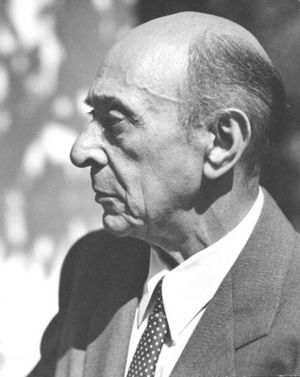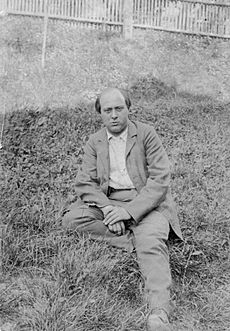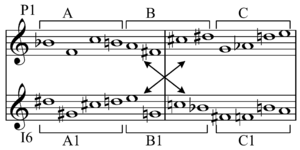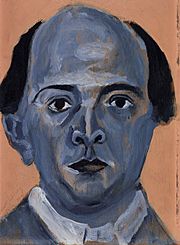Arnold Schoenberg facts for kids
Arnold Schoenberg (also spelled Schönberg) was an important Austrian-American composer, music thinker, teacher, writer, and painter. He lived from September 13, 1874, to July 13, 1951. Many people see him as one of the most important composers of the 20th century.
Schoenberg was part of the Expressionist movement in art and poetry. He also led a group of composers called the Second Viennese School. Because he was Jewish, the Nazi Party attacked him. They called his music "degenerate music" and stopped it from being published. In 1933, he moved to the United States and became an American citizen in 1941.
Schoenberg's ideas about music, especially how he used harmony and developed musical themes, greatly influenced 20th-century music. Many composers built on his ideas, while others strongly disagreed with them.
Early in his career, Schoenberg was known for combining two different German Romantic styles: those of Brahms and Wagner. Later, he became famous for new ways of writing music without a clear key (though he didn't like the term "atonality"). This became a very debated part of 20th-century classical music. In the 1920s, Schoenberg created the twelve-tone technique. This was a new way to compose music using all twelve notes of the chromatic scale in a special order. He also invented the idea of "developing variation," which means changing small musical ideas (called motifs) over time.
Schoenberg was also a very important music teacher. Some of his famous students included Alban Berg, Anton Webern, and John Cage. Many of Schoenberg's teaching methods, like how he organized composition and encouraged people to think deeply about music, influenced music throughout the 20th century. His strong opinions about music history also shaped how many music experts and critics thought about music.
Today, Schoenberg's important papers and works are kept at the Arnold Schönberg Center in Vienna, Austria.
Biography
Early Life and Musical Beginnings
Arnold Schoenberg was born into a middle-class Jewish family in Vienna, Austria. His father, Samuel, was a shoe shop owner. His mother, Pauline, was a piano teacher. Arnold mostly taught himself music. He only took a few lessons in counterpoint (a way of combining melodies) from composer Alexander Zemlinsky. Zemlinsky later became his brother-in-law.
In his twenties, Schoenberg made money by arranging music for operettas (light operas). At the same time, he wrote his own pieces. One famous early work was the string sextet Verklärte Nacht ("Transfigured Night") from 1899. He later made an orchestral version of this piece, which became very popular.
Two famous composers, Richard Strauss and Gustav Mahler, recognized Schoenberg's talent early on. Strauss noticed him after hearing Schoenberg's Gurre-Lieder. Mahler became a supporter after hearing some of Schoenberg's first works. Mahler even worried about who would take care of Schoenberg after his own death. Schoenberg, who at first didn't like Mahler's music, changed his mind after hearing Mahler's Third Symphony. He called it a work of genius and later spoke of Mahler "as a saint."
In 1898, Schoenberg became a Christian in the Lutheran church. Some say this was to connect more with European culture. It may also have been a way to protect himself during a time when anti-Semitism (hatred of Jewish people) was growing. However, in 1933, after much thought, he returned to Judaism. He realized his Jewish heritage was a part of him. He also wanted to clearly stand against the Nazis.
Experimenting with Atonality (1901–1914)
In 1901, Schoenberg married Mathilde Zemlinsky, the sister of his teacher. They had two children, Gertrud and Georg.
Around 1908, Schoenberg's music began to change. He started writing music that did not follow traditional keys. This was a big step away from how music had been written for centuries. One of his first pieces without a clear key was the thirteenth song in his cycle Das Buch der Hängenden Gärten, Op. 15.
Also in 1908, Schoenberg finished his String Quartet No. 2. The first two parts still used traditional keys. But the last two parts included a singer and started to move away from traditional tonality (music with a central key).
In 1910, Schoenberg wrote Harmonielehre (Theory of Harmony). This book is still one of the most important music theory books today.
One of his most famous works from this period is Pierrot lunaire, Op. 21, from 1912. This piece is a cycle of songs based on poems. It uses a special singing style called Sprechstimme, which is like spoken recitation but with musical pitches. The work features a female singer and a small group of five musicians. This group, now called the Pierrot ensemble, includes a flute, clarinet, violin, cello, and piano.
World War I and New Ideas
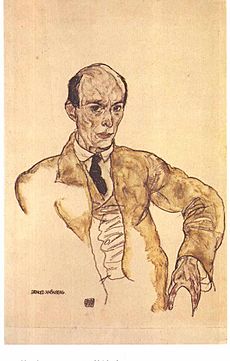
World War I (1914-1918) greatly affected Schoenberg. He was 42 when he joined the army. Military service made it hard for him to compose without interruption. Because of this, he left many works unfinished. Once, an officer asked if he was "this notorious Schoenberg." He replied, "Yes, sir. Nobody wanted to be, someone had to be, so I let it be me." This showed his feeling that he was meant to change music.
Schoenberg believed that the relationship between modern composers and the public was getting worse. So, in 1918, he started the Society for Private Musical Performances in Vienna. He wanted a place where new music could be practiced carefully and performed well. This way, the music would be judged on its own merit, not by trends or money. The Society held 353 performances until 1921, when it closed due to money problems. For the first year and a half, Schoenberg did not allow his own works to be played. Instead, the Society performed difficult new pieces by other composers like Scriabin, Debussy, and Mahler.
Developing the Twelve-Tone Method
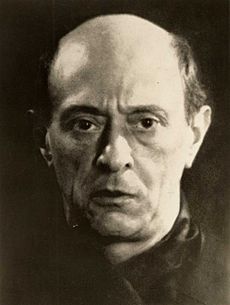
Later, Schoenberg created the most famous version of the twelve-tone method of composing. This method is also called serialism. In this technique, all twelve notes of the musical scale are used equally. No single note or key is more important than another. Schoenberg saw this as a natural step in music, similar to Albert Einstein's discoveries in physics. He famously said, "I have made a discovery which will ensure the supremacy of German music for the next hundred years."
Many of his students, including Anton Webern, Alban Berg, and Hanns Eisler, adopted this technique. They formed what is known as the Second Viennese School. Schoenberg also wrote several books on music, like Harmonielehre (Theory of Harmony), which are still used by musicians today.
Schoenberg's first wife passed away in 1923. The next year, he married Gertrud Kolisch. They had three children: Nuria, Ronald, and Lawrence. Gertrud wrote the story for Schoenberg's opera Von heute auf morgen.
In 1925, Schoenberg was offered a teaching job at the Prussian Academy of Arts in Berlin. He started in 1926. His students there included Robert Gerhard and Nikos Skalkottas.
Around 1930, Schoenberg also started writing some pieces that returned to traditional tonality (music with a clear key), even while developing his twelve-tone method.
Moving to the United States
Schoenberg continued teaching in Berlin until the Nazi regime came to power in 1933. While on vacation in France, he was warned that it was dangerous to return to Germany. Schoenberg officially returned to the Jewish religion in a Paris synagogue. Then, he and his family moved to the United States.
His first teaching job in the U.S. was in Boston. He then moved to Los Angeles, California. He taught at the University of Southern California and the University of California, Los Angeles (UCLA). Both universities later named music buildings after him. He bought a house in Brentwood Park, near UCLA. There, he became friends with composer George Gershwin. The Schoenbergs often hosted Sunday gatherings with coffee and Viennese pastries. Famous guests included conductor Otto Klemperer and actor Harpo Marx.
After moving to the U.S. in 1933, Schoenberg started spelling his name Schoenberg instead of Schönberg. He said this was to fit in with American customs.
He lived in the U.S. for the rest of his life. However, he did consider moving to other places like Australia or New Zealand. He had always been fascinated by islands.
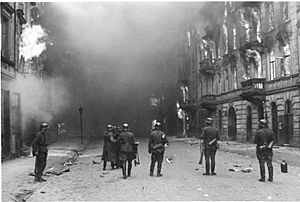
During his last years, he wrote several important works. These include the difficult Violin Concerto (1934/36) and the moving A Survivor from Warsaw (1947). This piece was written to remember the victims of the Holocaust. He also worked on his opera Moses und Aron, which was one of the first operas written entirely using the twelve-tone method. He also wrote some tonal works during this time, like the Suite for Strings in G major (1935). In 1941, he became a U.S. citizen.
Superstition and Death
Schoenberg was very superstitious, especially about the number 13. He had triskaidekaphobia, which is a fear of the number 13. He worried he would die in a year that was a multiple of 13.
In 1950, on his 76th birthday, an astrologer (someone who studies stars to predict the future) sent him a note. The astrologer warned him that the year was dangerous because 7 + 6 = 13. This made Schoenberg very sad and worried.
He died on Friday, July 13, 1951, just before midnight. His wife, Gertrud, said he died at 11:45 p.m. She wrote that his throat rattled twice, his heart beat strongly, and then he was gone.
Schoenberg's ashes were later buried in the Zentralfriedhof (Central Cemetery) in Vienna in 1974.
Music
Schoenberg's important musical works span over 50 years. His music is often divided into three main periods. However, this division is just a way to understand his work, as his music changed a lot even within these periods. Many important musical ideas, especially how he developed small musical themes, are present throughout all his periods.
The first period, from 1894 to 1907, shows the influence of late Romantic composers. It also connects with the "expressionist" art movement. The second period, from 1908 to 1922, is known for leaving behind traditional key centers. This is often called "free atonality" (though Schoenberg didn't like that term). The third period, starting in 1923, began with Schoenberg's invention of the twelve-tone (or "dodecaphonic") method of composing. His most famous students, Hanns Eisler, Alban Berg, and Anton Webern, followed his musical journey. They also added their own experiments and styles.
First Period: Late Romantic Style
Schoenberg's early works, like his songs and string quartets from around 1900, showed a unique blend of styles. He combined elements from Brahms and Wagner. Most people at the time saw these two composers as complete opposites.
For example, Schoenberg's Six Songs, Op. 3 (1899–1903), have a clear tonality (sense of key) like Brahms and Mahler. They use balanced musical phrases. But the songs also use unusual chromaticism (notes outside the main scale). They try to create musical ideas that represent things, like Wagner's "leitmotifs."
This blend of styles is best seen in his Verklärte Nacht, Op. 4 (1899). This piece tells a story through music for a string sextet (six string instruments). It develops several distinct musical themes. The only musical ideas that stay throughout the piece are those that are constantly changed and combined. Schoenberg called this technique "developing variation," which he saw in Brahms's music.
Second Period: Free Atonality
From 1908 onward, Schoenberg's music explored ways to write without traditional keys or tonal centers. His first piece that was clearly atonal (without a key) was the second string quartet, Op. 10, which included a soprano singer. The last part of this piece has no key signature. This showed Schoenberg's formal break from traditional harmonies.
Other important works from this time include his song cycle Das Buch der Hängenden Gärten, Op. 15 (1908–1909). Also important are his Five Orchestral Pieces, Op. 16 (1909), and the influential Pierrot Lunaire, Op. 21 (1912). His dramatic work Erwartung, Op. 17 (1909), is also from this period.
The move away from traditional keys and dissonance-consonance (harsh-pleasing sound) relationships can be seen even earlier. His Chamber Symphony No. 1, Op. 9 (1906), is known for its use of whole-tone and quartal harmony (chords built on fourths). It also uses unusual combinations of instruments. Many of these features would become common in 20th-century chamber music.
Third Period: Twelve-Tone and Tonal Works
In the early 1920s, Schoenberg worked on a new way to organize his music. He wanted to make it simpler and clearer. This led to his "method of composing with twelve tones which are related only with one another." In this method, all twelve pitches of the musical octave are treated as equal. No single note or key is given special importance, unlike in classical harmony.
This period includes the Variations for Orchestra, Op. 31 (1928). Also, the Piano Pieces, Opp. 33a & b (1931), and the Piano Concerto, Op. 42 (1942). Even though he is known for strict rules, Schoenberg used the twelve-tone technique in different ways for each piece. For example, his unfinished opera Moses und Aron is structured differently from his Phantasy for Violin and Piano, Op. 47 (1949).
Schoenberg's mature twelve-tone method has ten main features. These features work together and depend on each other. They include using groups of six notes (hexachords) in special ways. They also involve how all twelve notes are used together and how musical ideas are presented. The harmony and rhythm in his music also come from the properties of the twelve-tone row.
Personality and Other Interests
Schoenberg was also a very talented painter. His paintings were good enough to be shown alongside those of famous artists like Franz Marc and Wassily Kandinsky. They were all part of the expressionist art group called Der Blaue Reiter.
He was also interested in Hopalong Cassidy films, which were Western movies.
Images for kids
-
Arnold Schoenberg by Egon Schiele, 1917
-
Arnold Schoenberg, 1927, by Man Ray
-
Warsaw Ghetto Uprising. In 1947 Schoenberg wrote A Survivor from Warsaw in commemoration of this event.
-
Featuring hexachordal combinatoriality between its primary forms, P1 and I6, Schoenberg's Piano Piece, Op. 33a, tone row contains three perfect fifths, which is the relation between P1 and I6, and a source of contrast between "accumulations of 5ths" and "generally more complex simultaneity". For example, group A consists of B♭-F-C-B♮, while the "more blended" group B consists of A-F♯-C♯-D♯
See also
 In Spanish: Arnold Schönberg para niños
In Spanish: Arnold Schönberg para niños
- Arnold Schönberg Complete Edition
- Arnold Schönberg Prize
- List of refugees


